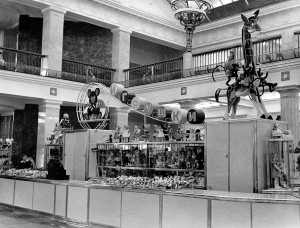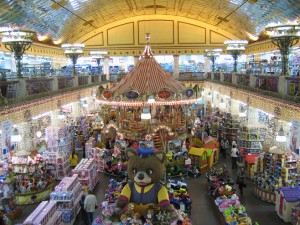Andrew Chapman, Dartmouth College
On 31 March 2015 The Central Children’s Store at Lubianka (Tsentral’nyi magazin na Lubianke) opened with great fanfare. The store, which originally opened in the same location in 1957, was then, and is now, one of the largest complexes of children’s stores in the world. In 1957 the complex was named Children’s World (Detskii mir)[1], serving as a materialized dream world of children’s culture. Far superior to anything else inside the USSR, citizens from throughout the Soviet republics flocked to Children’s World to shop for quality made toys, both Soviet and foreign.

Children’s World exemplified Nikita Khrushchev’s attitude toward consumption, which in many ways was a reprisal to the consumerist opportunism of the Stalinist era. A byproduct of Stalin’s great purges, fluid conditions of social mobility afforded to some the material comforts of what Soviet ideology promised for all in slogans such as “Life is getting better.” Khrushchev was disgusted with these empty and misleading proclamations, which he dubbed the “varnishing of reality” (lakirovka), and instead sought a different approach to consumption. He sought to channel Soviet consumers’ so-called uncontrollable desires for individual wealth to a more rationalized approach to acquire simple, yet quality material goods. Unlike western advertising and product placement in entertainment, it was Soviet culture’s job to direct consumers toward a line of Soviet products that were safe from the commoditized excesses of capitalist branding.
Children’s World was just one small part of the massive, ongoing post-World War Two rebuilding project, which attempted to both memorialize the past, yet provide new opportunities to completely remake the Soviet landscape. Children’s culture became a great vehicle to represent the post-war rebirth of the Soviet Union, and at the same time, convey a separation with the past. Younger generations by way of their age could not be culpable or implicitly linked with Stalin’s reign. It is no coincidence that the Children’s World of Khrushchev opened on the same corner as the Lubianka headquarters, whose prison was closely associated with Stalin’s name.
Children’s World was just one small part of the massive, ongoing post-World War Two rebuilding project, which attempted to both memorialize the past, yet provide new opportunities to completely remake the Soviet landscape. Children’s culture became a great vehicle to represent the post-war rebirth of the Soviet Union, and at the same time, convey a separation with the past. Younger generations by way of their age could not be culpable or implicitly linked with Stalin’s reign.[2] It is no coincidence that the Children’s World of Khrushchev opened on the same corner as the Lubianka headquarters, whose prison was closely associated with Stalin’s name.

In today’s Russian Federation, The Central Children’s Store chose to engage this proximity with the Lubianka headquarters as part of its advertising campaign. They promoted the reopening of their store with an online commercial that features two children interrogating their parents.
Source: “Children Care” (2015)
The video begins with two children performing the interrogation on the parents, who sit before the children with a floodlight flashing on and off in their faces. While the severity of scene is undermined by playful jazz music, the son’s fiddling with a toy gavel, and of course, by the absurdity of the role-play itself, the commercial appropriates history with extremely questionable taste. The slogan for the store closes out the commercial, proclaiming, “Love your kids? Take them to Lubianka.”
The commercial plays with our assumption of innocent children, and in turn, recasts them as culpable NKVD officers. But are we led to think that these kids are henchman of a state-imposed terror or are we seeing the rewriting of history that dares to sympathize with the state? I would lean toward the latter. At the heart of this transformation is the use of the anachronistic child to interpret history. Unlike the narrative of the innocent child which was appropriated during Khrushchev’s Thaw in order to make a break with the past, we see here the dangerous past coming very much into play, made softer and playful through the child’s oblivious reenactment. The commercial is a kind of historical rebranding, where the word Lubianka, which was once synonymous with and only with state terror, changes meaning. As the Lubianka toy store opens, other “stores” of historical memory are shut down, not unlike the recent closing of a gulag museum in Perm.[3]
There is yet another discourse running through the opening of The Central Children’s Store: the state as welfare provider. Although The Central Children’s Store is a private venture, its nostalgic naming uses the rhetoric of state central planning to promote abundance during a time of foreign economic sanctions. Children’s World was the central mecca for toys during the Soviet era, providing wonder for its young citizens during a time of rebuilding and growing domestic stability. While Russia’s current rank and file citizens see their salaries stretched thinner and thinner in a difficult purchasing economy, they are looking to the state for reassurances rather than perform their own interrogation of the state. This commercial, however, has received a thorough interrogation, and the Children’s Store has removed the advertisement from their YouTube page.
April 2015
[1] The Central Children’s store could not use the historic brand name, since it already exists as a Moscow-area chain of toy stores.
[2] See Oliphant on the recent closing of the museum to the Perm 36 camp.
[3] A number of films feature child heroes who are diametrically opposed to their elders: Marlen Khutsiev’s Two Fedors (1959), Sergei Bondarchuk’s Serezha (1960), and Andrei Tarkovskii’s Ivan’s Childhood (1962). See Peacock, for an analysis on ideal children figures in Soviet Film.
Works Cited:
“Children Care.” “Love Your Kids? Take them to Lubianka.” YouTube. https://www.youtube.com/watch?feature=player_detailpage&v=kiPiiDLEFjo. 25 March 2015.
d’Amora, Delphine. “Soviet Union’s Top Toy Store Back in Business.” The Moscow Times. http://www.themoscowtimes.com/business/article/soviet-unions-top-toy-store-back-in-business/518349.html. 31 March 2015.
Oliphant, Roland. “Russia’s only gulag museum faces closure.” The Telegraph. http://www.telegraph.co.uk/news/worldnews/europe/russia/11481113/Russias-only-gulag-museum-faces-closure.html. 18 March 2015.
Peacock, Margaret. Innocent Weapons: The Soviet and American Politics of Childhood in the Cold War. Chapel Hill, NC: University of North Carolina Press, 2014.
Varlamov, Ilya. Tsentral’nyi Detskii Mir. http://varlamov.me/ru/centralnyy-detskiy-mir. 3 April 2013.
